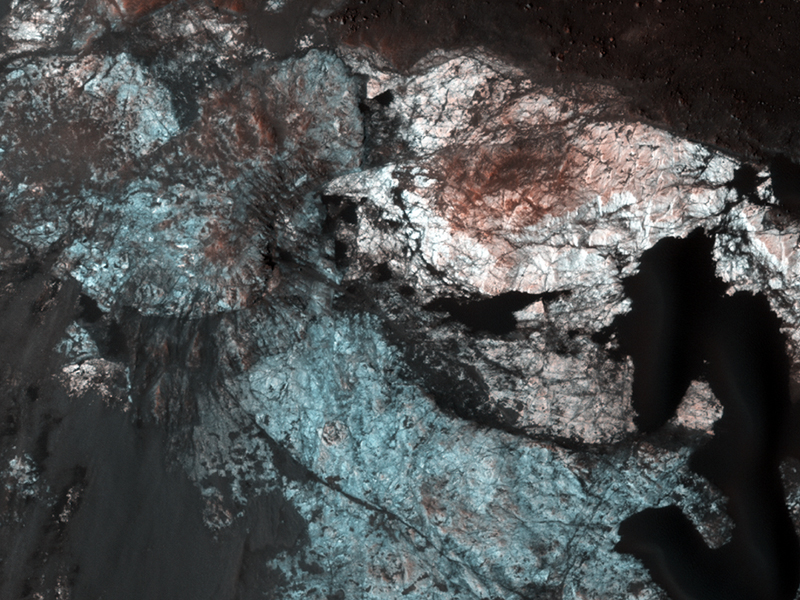Alfred McEwen wrote:Three Dust Devils (ESP_025985_2160)
There are three active dust devils in this image, but they aren't monsters like this picture.
Especially interesting is the stereo anaglyph with ESP_026051_2160, acquired just two weeks after this one.
Viewed with red-green glasses, the active dust devils seem to float above the surface. There are also some bright lines present in only the later image--those are the tracks of dust devils that passed through this region in the prior two weeks.
This is a stereo pair with ESP_026051_2160.
Alfred McEwen wrote:Colorful Uplifted Rocks (ESP_026388_2300)
Large impact craters have central regions of uplifted bedrock, a rebound effect following the tremendous energy of a hypervelocity impact. This produces windows into the deep and more ancient geologic history.
Central peaks on Mars have some of the most diverse and distinctive rock types. In this enhanced-color subimage we see two distinctive bedrock colors--light blue and purple--plus reddish to black fine-grained materials covering some of the rock. These rocks are generally massive or jumbled, and do not show regular layers like lava flows or water-lain sediments. One possibility is that these are plutonic rocks, where molten rock solidified at depth rather than erupted onto the surface as lava flows or particles.
Analysis of the CRISM spectra here should provide further clues. This spot is in the vast northern plains, where some workers believe there was an ancient ocean. So far, the mineralogic signature of ocean-deposited sediments has not been reported.
Alfred McEwen wrote:Layered Bedrock in Nili Fossae Region (ESP_026570_2025)
The Nili Fossae region contains some of the best exposures of ancient bedrock on Mars.
Ancient bedrock can be tilted, folded, and generally complicated and difficult to understand, but the center of this image shows a stack of nearly horizontal layers. These layers might record how the environment on ancient Mars changed over time, and would be a good site for future exploration by a rover.
The differing colors indicate different rock types of alteration. The darkest patches of ground probably consist of volcanic sand that is trapped in relative low areas. The reddest patches may be covered by dust.
Laszlo Kestay wrote:A Flow Margin in Phlegra Dorsa (ESP_026738_2080)
These HiRISE images form a stereo pair to examine the topography of the margin of a flow.
The Phlegra Dorsa region consists of ancient hills that have been surrounded and partially buried by flows from the Cerberus Fossae to the south. These flows could have been mud-laden water floods or very large lava flows.
The margin visible here is similar to that on lava flows that have had a long history of liquid lava being injected underneath the solidified crust. Relatively fresh impact craters and recent dust devil tracks are also visible in this image.
The second half of this stereo pair has another well-known formation.
Credit: NASA/JPL/University of Arizona
<< Previous HiRISE Update



